《机器学习Python实现_10_07_集成学习_bagging原理及实现》
一. 简介
Bagging的思路很简单,对大小为\(n\)的样本集进行\(n\)次重采样得到一个新的样本集,在新样本集上训练一个基学习器,该过程执行\(m\),最后对这\(m\)个基学习器做组合即得到最后的强学习器:
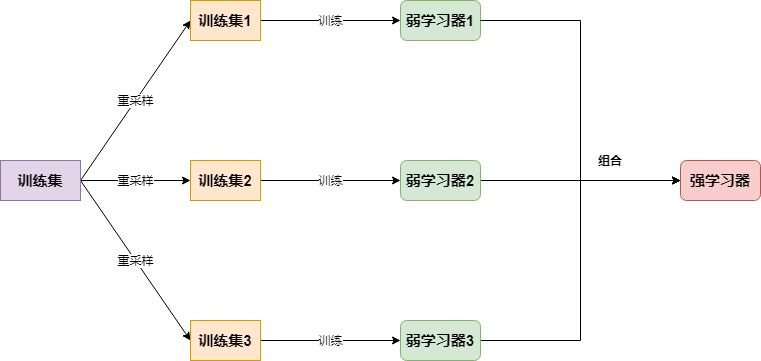
二.代码实现:分类
import os
os.chdir('../')
from ml_models import utils
import copy
import numpy as np
from ml_models.tree import CARTClassifier
"""
bagging分类实现,封装到ml_models.ensemble
"""
class BaggingClassifier(object):
def __init__(self, base_estimator=None, n_estimators=10):
"""
:param base_estimator: 基学习器,允许异质;异质的情况下使用列表传入比如[estimator1,estimator2,...,estimator10],这时n_estimators会失效;
同质的情况,单个estimator会被copy成n_estimators份
:param n_estimators: 基学习器迭代数量
"""
self.base_estimator = base_estimator
self.n_estimators = n_estimators
if self.base_estimator is None:
# 默认使用决策树
self.base_estimator = CARTClassifier()
# 同质分类器
if type(base_estimator) != list:
estimator = self.base_estimator
self.base_estimator = [copy.deepcopy(estimator) for _ in range(0, self.n_estimators)]
# 异质分类器
else:
self.n_estimators = len(self.base_estimator)
def fit(self, x, y):
# TODO:并行优化
n_sample = x.shape[0]
for estimator in self.base_estimator:
# 重采样训练集
indices = np.random.choice(n_sample, n_sample, replace=True)
x_bootstrap = x[indices]
y_bootstrap = y[indices]
estimator.fit(x_bootstrap, y_bootstrap)
def predict_proba(self, x):
# TODO:并行优化
probas = []
for estimator in self.base_estimator:
probas.append(estimator.predict_proba(x))
return np.mean(probas, axis=0)
def predict(self, x):
return np.argmax(self.predict_proba(x), axis=1)
#造伪数据
from sklearn.datasets import make_classification
data, target = make_classification(n_samples=100, n_features=2, n_classes=2, n_informative=1, n_redundant=0,
n_repeated=0, n_clusters_per_class=1, class_sep=.5,random_state=21)
#同质
classifier = BaggingClassifier()
classifier.fit(data, target)
utils.plot_decision_function(data, target, classifier)
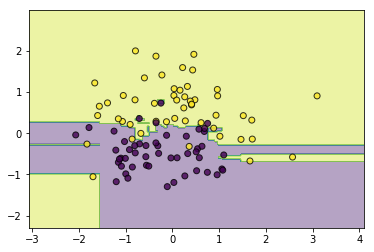
#异质
from ml_models.linear_model import LogisticRegression
from ml_models.svm import SVC
classifier = BaggingClassifier(base_estimator=[LogisticRegression(),SVC(kernel='rbf',C=5.0),CARTClassifier(max_depth=2)])
classifier.fit(data, target)
utils.plot_decision_function(data, target, classifier)
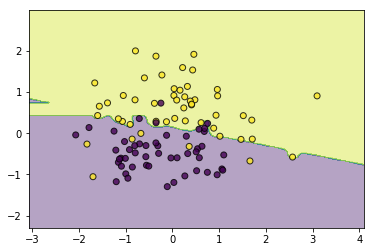
三.代码实现:回归
from ml_models.tree import CARTRegressor
"""
bagging回归实现,封装到ml_models.ensemble
"""
class BaggingRegressor(object):
def __init__(self, base_estimator=None, n_estimators=10):
"""
:param base_estimator: 基学习器,允许异质;异质的情况下使用列表传入比如[estimator1,estimator2,...,estimator10],这时n_estimators会失效;
同质的情况,单个estimator会被copy成n_estimators份
:param n_estimators: 基学习器迭代数量
"""
self.base_estimator = base_estimator
self.n_estimators = n_estimators
if self.base_estimator is None:
# 默认使用决策树
self.base_estimator = CARTRegressor()
# 同质
if type(base_estimator) != list:
estimator = self.base_estimator
self.base_estimator = [copy.deepcopy(estimator) for _ in range(0, self.n_estimators)]
# 异质
else:
self.n_estimators = len(self.base_estimator)
def fit(self, x, y):
# TODO:并行优化
n_sample = x.shape[0]
for estimator in self.base_estimator:
# 重采样训练集
indices = np.random.choice(n_sample, n_sample, replace=True)
x_bootstrap = x[indices]
y_bootstrap = y[indices]
estimator.fit(x_bootstrap, y_bootstrap)
def predict(self, x):
# TODO:并行优化
preds = []
for estimator in self.base_estimator:
preds.append(estimator.predict(x))
return np.mean(preds, axis=0)
#构造数据
data = np.linspace(1, 10, num=100)
target1 = 3*data[:50] + np.random.random(size=50)*3#添加噪声
target2 = 3*data[50:] + np.random.random(size=50)*10#添加噪声
target=np.concatenate([target1,target2])
data = data.reshape((-1, 1))
#同质
import matplotlib.pyplot as plt
model=BaggingRegressor(base_estimator=CARTRegressor(),n_estimators=2)
model.fit(data,target)
plt.scatter(data, target)
plt.plot(data, model.predict(data), color='r')
[<matplotlib.lines.Line2D at 0x23184b7f908>]
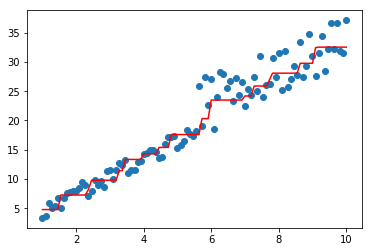
#异质
from ml_models.linear_model import LinearRegression
model=BaggingRegressor(base_estimator=[LinearRegression(),CARTRegressor()])
model.fit(data,target)
plt.scatter(data, target)
plt.plot(data, model.predict(data), color='r')
[<matplotlib.lines.Line2D at 0x23198e4e3c8>]
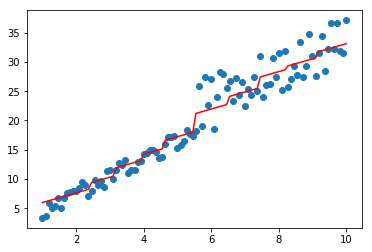
四.问题讨论
下面简单推导一下,重采样会有多少比例的样本未能被抽到,已知道总样本量为\(m\),那么每轮任一样本未被抽中的概率为\(\frac{m-1}{m}\),所以\(m\)轮未被抽中的概率为\((\frac{m-1}{m})^m\),对\(m\)取极限可得:
\[\lim_{m\rightarrow \infty}(1-\frac{1}{m})^m=\frac{1}{e}\approx0.368
\]
简单验证一下:
ratios=[]
#最小样本量
min_sample=100
#最大样本量
max_sample=1000
#每次实验重复次数
repeat_num=100
for n_sample in range(min_sample,max_sample):
tmp=[]
for _ in range(0,repeat_num):
new_indices=np.random.choice(n_sample,n_sample,replace=True)
tmp.append(1-len(set(new_indices))/n_sample)
ratios.append(np.mean(tmp))
plt.plot(ratios)
[<matplotlib.lines.Line2D at 0x23198f78780>]

作者: 努力的番茄
出处: https://www.cnblogs.com/zhulei227/
关于作者:专注于机器学习、深度学习、强化学习、NLP等领域!
本文版权归作者和博客园共有,欢迎转载,但未经作者同意必须保留此段声明,且在文章页面明显位置给出.




 浙公网安备 33010602011771号
浙公网安备 33010602011771号